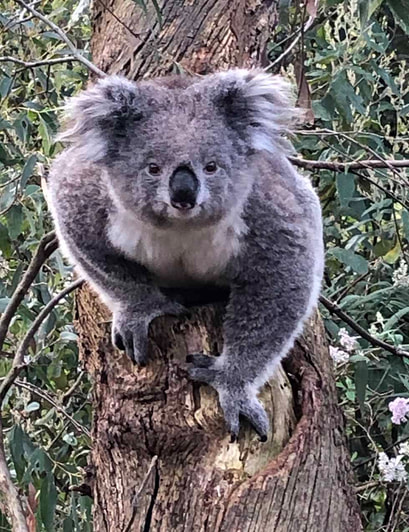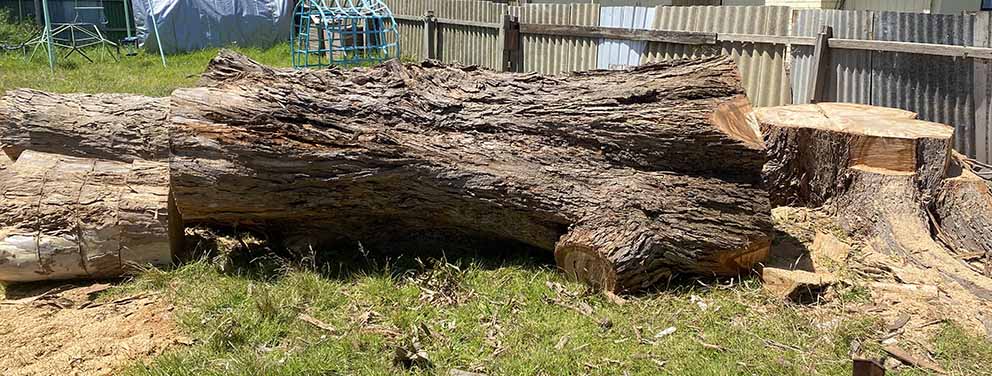 We must lay down our chainsaws while there is still some remnant vegetation to save, Photo: John Cuttriss
We must lay down our chainsaws while there is still some remnant vegetation to save, Photo: John Cuttriss I SIT on the balcony of my in-laws’ place in Inverloch and I can nearly touch the koala in the large remnant narrow leaf peppermint tree before me. This koala comes often as this tree makes up part of its dwindling habitat. The property is quarter of an acre, a formerly standard urban block, but there is nothing standard in the species diversity it holds. If there was a grading system for private citizens’ contribution to our urban forest these guys would be top of the class, gold stars all round, but currently the only assessment of their contribution to our community are the dozens of native flora and fauna species this property supports.
An urban forest is made up of all vegetation in an urban area, on both private and public lands. In Bass Coast we have average canopy coverage of 21 per cent. While that’s more than many of our neighbouring local government areas, it needs expanding. Canopy coverage below 25 per cent leads to a decline in community health. The strategy aims to increase canopy coverage to 40% by 2040.
Over 200 residents responded in the initial community consultation and they were adamant that our remnant vegetation must be protected:
- 82% of respondents recognised the importance of trees on private property.
- 53% think the council should require greater regulatory protection over them, with realistic allowances for circumstances in which trees or vegetation need to be removed.
- 81% of respondents support the council developing incentives for tree protection and planting on private property.
While these intentions are bold and ambitious, there are significant obstacles to achieve them. Council-managed land only makes up 24% of our urban township areas. Most of the rest is on private land and there is no timeline.
The strategy identifies that only 14% of Bass Coast’s native vegetation remains but it does not acknowledge that in the Gippsland bioplains area only 1% of our remnant vegetation exists in an ‘intact landscape’ in one continuous tract.
The irony of wanting to save an urban forest in a landscape denuded of forest is not lost on me, yet I am compelled by sheer stubbornness. Trees and nature sit so strongly within my psyche. Given the chance, this awe exists in all children, in all humans. I recall teaching a class of Year 10 students in Wonthaggi. I was describing the magic of a forest and received blank looks from some students: four students had never seen a forest. That shocked me. The next day I booked an excursion for my Year 10 classes to Wilsons Prom.
How are you supposed to value a forest if you have never seen one? How can you appreciate the value of a tree if you’ve never strained to see its uppermost canopy? We are not living in communities surrounded by great forests: to the south there is sea, to the north there is agricultural land. There is so little native vegetation in our region that even the most common species are under threat. Biolinks will help…if there is remnant vegetation to link to. The only functioning forest we have is the Western Port Woodlands and that’s set to become sandpits if the State Government doesn’t hear our community’s pleas at the Distinctive Areas and Landscapes hearings approaching in March.
Ninety per cent of our land use in Bass Coast is agricultural. Driving down Lynnes Road in Wattle Bank you can observe how the remnant bush is often used for grazing. While some landowners are clearly stewards of the bush, other sections are bereft of mid and floor storey vegetation as the vegetation has been trampled by hooves. The trees are ringbarked and it is only a matter of time until the remnant woodland becomes grassland. While there are protections to stop farmers from clearfelling remnant trees, there is nothing to stop them from grazing it.
The expansion of urban areas continues to erode the 1% sliver of remnant vegetation. Subdivision of large treed blocks in Bass Coast is equally damaging. Ed Thexton, president of the South Gippsland Conservation Society, says that with block sizes dramatically decreasing, houses increasingly taking up 80% of a block (with further underground infrastructure) and solar panels needing full sun, there is no room on our modern urban blocks for big trees. This has a significant impact on the community with the creation of urban heat islands and a dramatic reduction in storm water filtration.
The strategy recognises that urban development is a challenge and says it will ‘investigate’ incentives for retention of vegetation and develop a policy to ensure that tree retention is part of the planning and construction phase of subdivisions.
What about footprint limitations for new builds? This might deter the cutting up of urban blocks into smaller and smaller pieces. We want more detail and we want it in effect now.
Bass Coast Local Law 30, enacted last year, establishes a Significant Tree Register and is a pivotal to the strategy. Permits are now required to prune, remove or work in the tree zone of trees (other than noxious weeds) with a circumference of 155cm or greater, measured 1 metre off the ground. However, it is not yet functioning in practice and there is no timeline.
 Photo: Sally McNiece
Photo: Sally McNiece “Oh God,” I think, “I’ve become my mother in law …”
He calls his boss, I call the council, but the tree has been felled by the time I’m on my way home. If I was vindictive, it might make me feel better that the owner of the block just unwittingly decreased their property value. But it does not.
We don’t know when or how Local Law 30 will be applied: Who will be fined – the landowner? The arborist? Will the consequence be enough to deter one or the other? What about a property developer?
Integrating the protection of vegetation into a planning scheme could take years. We don’t have that much time. What little remnant and native vegetation we have in our urban centres is down to slivers; enough to support a family of yellow breasted robins, perhaps, but not connected enough for them to move or expand into other territories. With the current rate of urbanisation in Bass Coast there may be little left in another two years.
The Urban Forest Strategy is an excellent step in the right direction but we need an interim measure while the legwork is done. And we want timelines, clear ones.
For the council to achieve their aspirations to retain remnant vegetation we need leadership and a significant cultural shift within our community. We must lay down our chainsaws and call a ceasefire, before there is nothing left to save.
